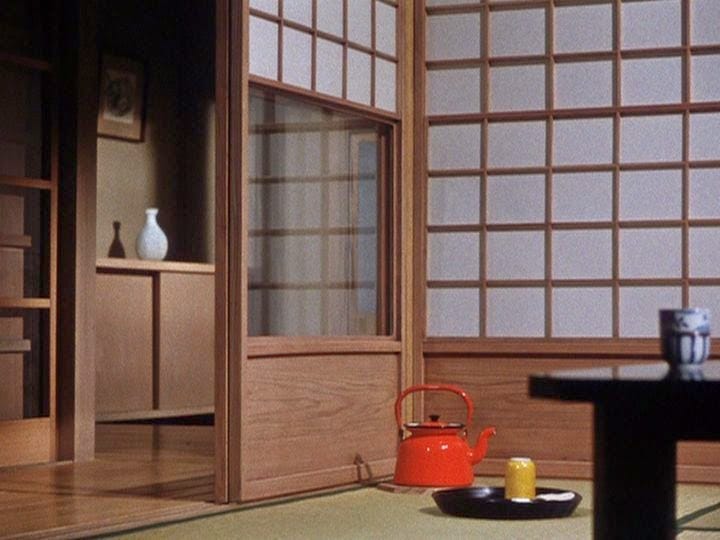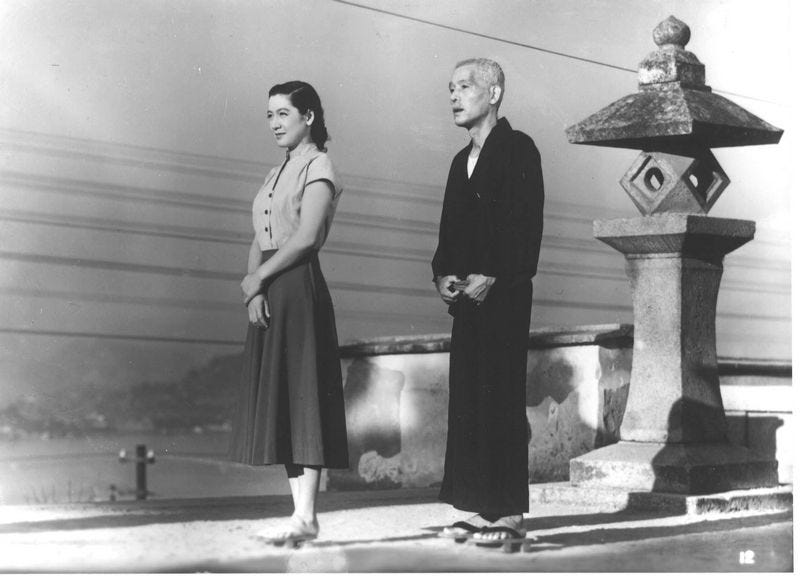WHAT OZU DOES
Equinox Flower [and others] — Yasujirō Ozu (1958)
You may not know that I (alongside filmmaker Ralph Pritchard) co-host a podcast. It’s called MUUB TUBE. Either together or with guests, we review the films that matter to us — aesthetically, formally; what have you. We’ve done micro series (like this one about Jean-Luc Godard), we’ve done instant reactions after screenings (like this), and we’ve covered film festivals (like New Horizons, Wroclaw, in July 2022). There are now over seventy episodes that really run the gamut (formally, nationally, generationally). You will probably enjoy it if you enjoy this newsletter. Feel free to listen and — as they say online — like, share, subscribe. Or you could carry on reading this.
— When I think about the cinema of Ozu, a kind of pleasant torpor descends over my body. First, I wonder if this is the right moment to watch his film. Later, this is replaced by a feeling that I don’t want the film to end – that the torpor has become a kind of strung-out bliss, even if what I’m seeing before my eyes is quite sad or fraught.
— Certain formal gestures come to typify the work of particular directors. For Ozu, I believe it’s how he treats the face — how he frames the face and how he directs conversation. This isn’t a new or revelatory observation. There’s also a lot to be said for his so-called ‘pillow shots’ and his use of internal framing. This isn’t new, either. But it’s fun to think about. I’ll get to those. But I’m suggesting that his particular poetics — of melancholy, of everyday life — plays a big part in conditioning my excited torpor toward his films.
— There’s a stateliness to it, a reverence of space. His is a 360 cinema, not a 180 cinema. When he shoots pivotal conversations (not all; just pivotal) he does so by lifting the entire machinery of his camera and setting it up again to re-frame the second speaker. You may have seen photos of his camera. He had a special mount created for it that elevated the body and lens only 3ft from the floor, meaning that his body – the cinematographer’s body, the grip, whoever’s — had to crouch down on the floor, bringing themselves level with the seated actors. There’s also a very slight craning up. They are head-on shots. The speakers face us.
— These head-on shots mean that the space between the speakers is not muddied or interpolated. They are their own islands, and they regularly look right through us. He relies on this technique during quite tense or revealing dialogues. Looking directly down the lens of the camera – a camera that frames her body immediately in the centre of her (Setsuko’s) gravity, the vanishing point flattened (deferred) toward the gaze which reflects back at you. Wataru’s reaction — framed similarly, identically — a space of seconds (coagulated time) that separates question and response. Voices rarely if ever overlap. A voice speaks, a voice returns – just as their eyes are locked, held in suspension. I’m talking about Equinox Flower, his first colour film. The year is 1958. But he used this device all the time, in the years preceding it.
— This lends his conversations a certain syrupyness. They draw out, and there are fractures of time between question and response. The whole effort of reframing the speaker introduces a certain artificiality to the dialogue, pads the space between their words (and bodies). A canyon emerges between them. It’s mildly disorienting. It’s like being high, in the way that being high sort of slows down and troubles the natural flow of life. You become much more attuned (with Ozu) to what exactly is being said, and you sort of languish in the space of his actor’s words. You’re not really waiting for the response because you know that it’ll happen in its own time. You really pay attention. For me this is typically Ozu. I can’t think of any other director who is this glacial, this syrupy, and to such quizzical effect. He’s not rushing you away from their face. You have time to look properly at them, to see what isn’t being put into words. These conversations vibrate with a palpable melancholy.
— His so-called pillow shots or intermediary shots are also very typical of his cinema, early or late. They’re often shot without figures/bodies – they seem empty, hollowed out and yet poignant with significance. In Equinox Flower, Wataru’s tension with his daughter stems from an anxiety that she will fly the family nest. He resists her wedding match because he fears irrelevance, he mourns her loss before she has departed. Ozu – to really emphasise this sense of departure — shows us softly lit, widely-framed spaces in the house (a vase casting a rubbed-out shadow; a chair, the frame of a door) as well as frames of the city – steely blue and grey, a little foggy, slightly clinical. We feel-into Wataru’s grief. We witness a world without her — the world he is imagining into existence. We feel the emptiness. These scenes often pad the spaces between conversations. We have a moment — for ourselves/to ourselves — to feel into their significance, their implications. Ozu doesn’t hurry us along.
— But there’s more. There’s Ozu’s internal framing. By this I mean the way in which he uses objects (doorways, trees, buildings) to frame his characters in the middle and long distance. The internal framing that typifies Ozu’s earliest cinema is still very much in force with Equinox Flower (doorways within the frame; a pair of great trees and a torii gate on the far shore, between which stand two figures — three frames functioning within the same shot).
— He also varies these rules up. Sometimes we see a group seated as an ensemble. Sometimes they even talk over each other (particularly when drinking). We see them sitting within the same frame. Here, above — Wataru and his wife, Kiyoko. They themselves frame the doorway beyond them, beyond their bodies. But their eyes do not lock, their gaze shooting in different directions. Ozu can use this device to establish a bond — how their bodies echo the frame of the house, their family home — while also drawing away from them, laying a fissure between them. We realize just how important how bearing is toward others; what it means. Ozu was very concerned with the natural cycle, with seasons and their interpolation with human relations. It’s why so many of his films (I think) bear titles relating to the natural world (Late Spring, Etc). The generations are deeply linked, yet these links are frayed — they erode and decay. “Life is absurd”. Life, discoloured by its pointlessness — or enhanced by it?
— Sometimes, he shoots from the side and sometimes he tucks his camera in a sort of perplexing corner of a room. But the overall approach is so very different from current modalities of filmmaking — a filmmaking that has bodies overlapping, shoulders and edges of heads (unfocused) interrupting other bodies. It’s a squashed frame. Ozu lends his actors — his characters — an immense bubble of space around them. Yes this plays into his kind of melancholia, but it also asserts a very tangible respect and authority to the individual. They are truly autonomous, but they’re also alone. Few other directors have ever really given us individuals, nor have they ever really formally defined the space of melancholy that arises between individuals during the course of a conversation (particularly when they hold their real motives back, as often happens in Ozu). You might think of this as a poetics of isolation. But a shared frame might help to bridge two characters together, to re-establish the bonds between them (like above — the close to Tokyo Story). For Ozu, space matters. It is filled [packed, dense with signification], yet it covers an almost infinite space.
I’ve seen some quite different takes on Ozu’s methodology. Norman Holland writes that:
where Hollywood makes you unaware of the camera (Bordwell’s “continuity cinema”), Ozu disorients you by breaking the customary rules. At the same time, his not moving the camera led to a kind of Buddhist effacing of the self of the director.
I’m not sure about the latter part — the effacing of the director. For me, Ozu remains one of the few filmmakers whose body (the physical interventions they have made into a space) seems immutable; and profoundly active. But Holland is correct that Ozu “disorients”. The matched shots that dominate the Hollywood mode (continuity) are not really present in Ozu. He is very much more concerned with the frame, of framing, and of the figurative reverberations that these frames send — shooting outwards — through his films. For this, he is a profoundly filmy director, and for all of the essays on Ozu which privilege his focus on the everyday, Ozu doesn’t really reify that everydayness — the mundanity of repetitive actions (pouring tea; serving food, Etc). These things happen, but they are not (from a matching/continuity perspective) given much focus. They happen, but they are not the primary site of action. This is because Ozu brings us very close to people — in terms of how he frames them, how he establishes islands around them — but he also pulls us away. We feel removed, yet we ache toward them. Ozu is an engineer. He creates space, but imagined space. He is a utopian architect whose building materials are melancholy, loneliness. Etc.
If you liked this newsletter then please consider liking, sharing or subscribing. It’s lonely here.







